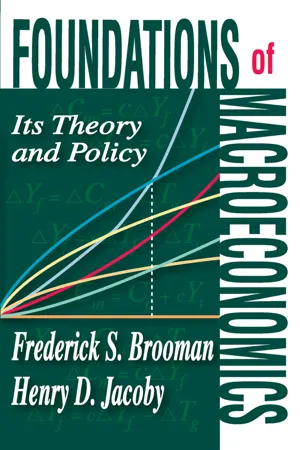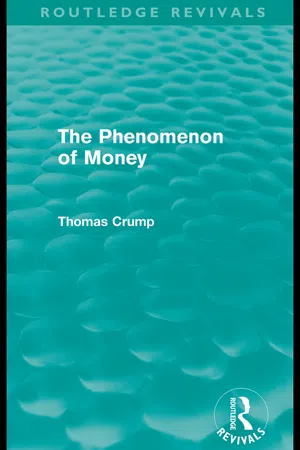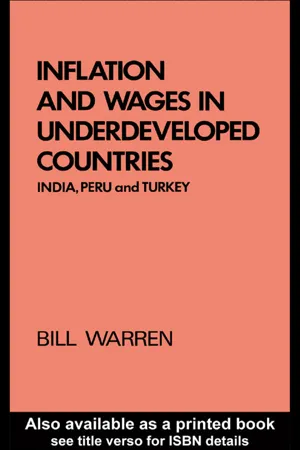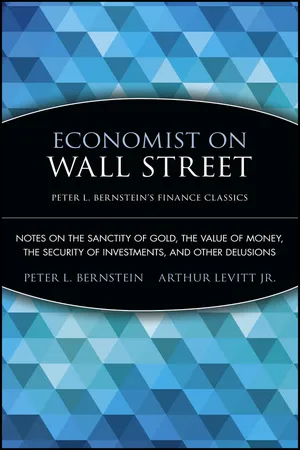Economics
Cost Push Inflation
Cost-push inflation occurs when the cost of production for goods and services increases, leading to higher prices for consumers. This can be caused by factors such as rising wages, increased raw material costs, or higher taxes. As production costs rise, businesses pass on these expenses to consumers through higher prices, resulting in inflation.
Written by Perlego with AI-assistance
Related key terms
Related key terms
1 of 4
Related key terms
1 of 3
6 Key excerpts on "Cost Push Inflation"
- eBook - ePub
Foundations of Macroeconomics
Its Theory and Policy
- Frederick S. Brooman(Author)
- 2017(Publication Date)
- Routledge(Publisher)
At the beginning of Section 2 it was assumed that influation was started by an autonomous increase in aggregate demand occurring at a time when output was already at its full-employment level: the excess demand “pulled” the price level of goods and services upward, and though the level of money wages also rose, it was a consequence and not a cause of the inflationary pressure. By contrast, in the “cost-push” theory of inflation, the causal sequence is reversed: the initial impulse is given by an autonomous rise in money wages or other input prices, in response to which the prices of “final” goods and services are raised to cover the increase in costs. The rise in prices, however, causes real wages to fall back to their previous level, and the forces that brought about the original rise in money wages then cause them to increase yet again, with the result that prices will be raised once more – and so on. At each stage, it is the rise in costs that pushes up prices; there does not have to be any excess demand for goods and services – indeed, the process could go forward even if aggregate demand were somewhat below the level needed for full-employment output.A basic assumption of the “cost-push” theory is the existence of strong labor unions that insist on compensating increases in money wages whenever the price level rises, so as to prevent any reduction in real wages; the labor market consequently has a “floor” of the kind described earlier in Chapter 4 (p. 93). From time to time, when the unions feel strong enough, they will try to increase the real wage by claiming money wage adjustments in excess of those needed merely to offset rising prices, and when they succeed, the increases will give the initial push that sets the wage-price spiral in motion. Alternatively, an autonomous rise in the cost of imported inputs may provide the push; as long as the unions respond to the consequent increase in output prices by forcing a rise in money wages, a cost-inflationary spiral will ensue. It is also assumed that business enterprises fix the selling prices of their products by calculating “direct” costs per unit of output (i.e. - eBook - ePub
- Krish Bhaskar, David F. Murray(Authors)
- 2015(Publication Date)
- Routledge(Publisher)
There are two further problems which we must mention here. Inflation is generally considered to be undesirable yet an annual increase in the general level of prices of, say, 1.5 per cent may be argued by some economists to be beneficial in stimulating economic growth whereas they would join the consensus of opinion against a 25 per cent per annum rise. The problem of deciding when the rate of increase in prices becomes unacceptable therefore remains. Secondly, a distinction is often made between price inflation which refers to the rate of increase of prices and wage inflation which refers to the rate of increase of money wages. Inflation is normally measured by the rate of increase of prices, although clearly wages and prices are closely related.Demand pull and Cost Push Inflation
The models considered earlier in the book have generally assumed a downward sloping aggregate demand curve and an upward sloping aggregate supply curve which provides a convenient framework within which to consider the two main ways in which price inflation may occur.The first is generally known as demand pull inflation and reflects a rightward shift in the aggregate demand curve as shown in Figure 15.1 . It is often loosely described as a situation where ‘too much money is chasing too few goods’ and is simply a situation where the demand for goods and services at the existing price level outweighs the supply, leading to an increase in the price level.Figure 15.1 The effect on the price level of an increase in aggregate demandIt is often argued that at less than full employment the aggregate supply curve is similar to that shown in Figure 15.1 but that as full employment is reached output cannot easily be increased, in the short run at least, and the aggregate supply curve becomes steeper as shown3 by the dotted line in Figure 15.1 . The effect of this is to generate a greater increase in the price level for a given movement in the aggregate demand curve.One source of theories of inflation is therefore concerned with the factors affecting the aggregate demand curve since this in turn affects the price level. These are the so-called demand pull theories. The second main approach to the theory of inflation is generally known as Cost Push Inflation and considers the factors which might produce a leftward shift in the aggregate supply curve as shown in Figure 15.2 - eBook - ePub
- Thomas Crump(Author)
- 2011(Publication Date)
- Routledge(Publisher)
This explains why ‘cost-push’, which is the alternative to ‘demand-pull’ inflation, is much easier to live with. In any sector to which it applies, it means that the prices of outputs have to be increased ‘defensively’, simply because of the increased cost of inputs—such as labour, or imported raw materials (Flemming, 1976, p. 12). Everything is blamed on the trade unions, or on the OPEC lands (particularly those whose religion is Islam). This latter case has the advantage of being able to show that the inflation is triggered off from outside the sphere of payment, allowing the authorities to adopt a convenient air of injured innocence.In considering the causes of inflation one is confronted with a vicious circle. There are quite logical arguments to prove that neither ‘cost-push’ nor ‘demand-pull’ can be a cause of inflation (Machlup, 1969, pp. 151f.). Inflation is in fact a vicious circle, and ‘demand-pull’ and ‘cost-push’ are little more than two sides of the same coin. So also, once inflation is started, is it difficult to distinguish between cause and effect, a point to be borne in mind in the following section.The consequences of inflation
The consequences of inflation are twofold: the redistribution of purchasing power and the revaluation of assets and liabilities. As to the first, each separate sector in the economic complex sees its money income increased at different stages in the inflationary cycle. For every such sector two factors are critical: the first is the amount of the increase accruing to it; the second, the time at which it occurs. The significance of the first factor may be evaluated in terms of the share of the sector concerned in the aggregate flow of money—MV in Fisher’s equation. The immediate result of an increase in the income accruing will be to increase this share, and although this must lead to a decrease in the share of other sectors, this need involve no loss in real terms so long as it corresponds to a rateable increase in productivity. That is, an increase in MV is not inflationary, so long as it leads only to an increase in T, with P remaining unchanged. If, however, this does not happen (which is the general case), the increase in P - eBook - ePub
- Fritz Machlup(Author)
- 2020(Publication Date)
- Routledge(Publisher)
average hourly earnings have increased faster than wage rates’ Some critics rightly point out that the presence of these symptoms does not rule out that some cost-push has contributed to the inflation of prices. Indeed it would have been possible that a cost-push actually initiated the process and that the compensatory monetary injection, expanding demand to avoid the threatening unemployment, turned out to be heavier than necessary. Thus while these tests can verify the existence of an inflation of demand, they cannot prove that it was excess demand that precipitated the inflation of consumer prices.Proposed Concepts and Distinctions
The diversity of expert opinion and the absence of any good statistical tests to support a diagnosis may in part be due to the lack of precise definitions. It is clear than an inflation of effective demand is a necessary condition not only for a demand-pull inflation of consumer prices but also for a cost-push inflation. Without an expansion of demand the cost boost would result in less production and less employment, not in a continuing rise of the level of consumer prices. Should one then speak of a demand-pull inflation only when the expansion in demand is clearly the initiating factor and any administrative cost increases are clearly induced? Or should one also speak of a demand-pull inflation if administrative wage and material-price increases start and lead the procession of events, but are then joined and overtaken by induced or compensatory expansions of demand? - eBook - ePub
Inflation and Wages in Underdeveloped Countries
India, Peru, and Turkey, 1939-1960
- Bill Warren(Author)
- 2005(Publication Date)
- Routledge(Publisher)
These circumstances are an urban working class in a strategic situation, whose demands are voiced in a political context which is generally unstable and rapidly changing. The effect of rapidly rising prices in these circumstances is to dramatise latent or existing feelings of exploitation 43 —even in circumstances in which money wages are rising faster than prices, 44 with the result that the political impetus to a rapid response of money wages to price increases is strengthened. There is some evidence that this has been a common phenomenon throughout the post-war under-developed world. 45 The implications of the effectiveness of the response of money wages to cost-of-living increases 46 is that the inflation barrier theory which we noted in Chapter 1 47 apparently more closely corresponds to reality than does the profit inflation theory, even if the reasons for the ability of wages to keep pace with rising prices relate to institutional rather than efficiency factors, and even if, for that very reason, the relationship between rates of rise in wages and prices is less determinate than implied by the efficiency theory. Turning from the relative movements of wages and final prices towards the relative movements of wages and raw material costs, we have the theory of relative cost changes during inflation associated with the name of Kalecki, according to which, assuming the degree of monopoly constant, labour’s share in value added declines in the short run (or the upward phase of the cycle) when raw material prices are rising. The argument leading up to this result may be deployed as follows: (a) ‘Prices of raw materials undergo larger cyclical fluctuations than wage rates’ (p. 24). 48 (b) This is because changes in money wages can never ‘catch up’ with changes in raw material prices since changes in money wages cause a change in demand which brings about a further change in raw material prices (p - eBook - ePub
Economist on Wall Street (Peter L. Bernstein's Finance Classics)
Notes on the Sanctity of Gold, the Value of Money, the Security of Investments, and Other Delusions
- Peter L. Bernstein(Author)
- 2008(Publication Date)
- Wiley(Publisher)
The theory behind the classic medicine for the treatment of inflationary diseases is simple and appealing. Prices go up because demand exceeds supply. Reduce demand, therefore, and prices will stop going up. Raise taxes, cut government spending, make business and consumer spending more difficult and expensive to finance. Businessmen will then find that with lower demand they are unable to sell everything they can produce; if they persist in raising prices, their competitors will steal their customers. Thus the overheating in the economy is reduced and the price level flattens out. The whole process is assisted by a slower pace of wage increases, as businessmen become a lot tougher about accepting higher costs when they are unable to pass them along so easily to their customers.Of course, there are other ways to fight inflation, among them wage and price controls or voluntary guidelines (known as an “incomes policy” in European countries). But such policies, according to advocates of the classic medicine, interfere with the free play of market forces, produce artificial and unfavorable allocations of resources, and, since they are difficult to administer, invite violation.But the trouble with the classic medicine of squeezing down demand is that it too can fail to work as it should. Ultimately, if prices continue to rise in the face of shrinking demands for goods and services, it seems pointless to press so hard on the economy that a depression results. Indeed, the heavy hand of fiscal conservatism and tight money fails on three counts.First, these policies seem to place little or no restraint on those important sectors of the economy where, as the economists put it, demand is inelastic—that is, where the customer is either determined or forced to keep buying, regardless of price increases. This is particularly the case in the service industries where, because of the high labor content, inflation keeps rolling merrily along no matter what the authorities do about taxes and interest rates. The prices of consumer services other than rent have gone up more than 50 percent in the past 10 years; they rose more than 7 percent in 1969 alone, more than twice as fast as the cost of the goods that consumers buy (wholesale prices, incidentally, are up only 15 percent in 10 years). Subway and commuter fares, haircuts, domestic help, medical care, and laundry and cleaning are just a few examples of this phenomenon.Ironically, the government’s cost of living goes up faster than anything else. The prices of goods and services purchased by government are rising about 10 percent faster than the prices that consumers pay. Civil servants, police, firemen, teachers, garbage collectors, council-men and Congressmen, and privates and generals are all demanding, and getting, more. No wonder, then, that state and municipal taxes keep going up, or that the President’s Spartan budget involves deep cuts in what many people would consider essential federal activities.
Index pages curate the most relevant extracts from our library of academic textbooks. They’ve been created using an in-house natural language model (NLM), each adding context and meaning to key research topics.
Explore more topic indexes
Explore more topic indexes
1 of 6
Explore more topic indexes
1 of 4





